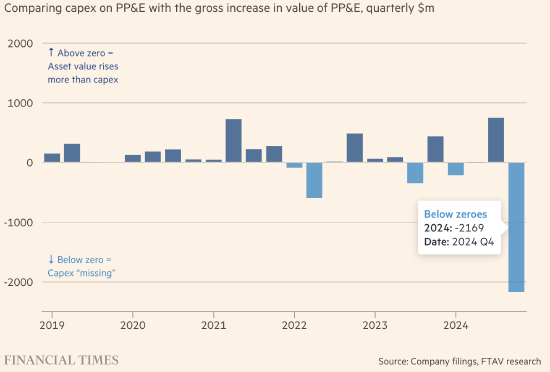Tesla's Accounting Under Scrutiny, Balance Sheet Reveals a $1.4 Billion Gap
A new report from the Financial Times indicates that Tesla's accounting practices have raised alarm, with a $1.4 billion gap discovered on the company's balance sheet.
For years, many short sellers and critics of Tesla have questioned the company's accounting, but until now, these questions have not garnered much attention.
However, a new report by the Financial Times points out a $1.4 billion asset gap: comparing Tesla's capital expenditures in the last six months of 2024 with the valuation of the assets it invested in, there appears to be $1.4 billion unaccounted for.
The article points out that Tesla reported spending $6.3 billion on "property, plant, and equipment" (PP&E) in the second half of 2024, while the property, factories, and equipment only increased by $4.9 billion during the same period.

Accounting experts generally agree that, in most cases, the amount of capital expenditures is closely related to the growth of total PP&E, but some factors may have an impact: sales or impairment of assets, foreign exchange, etc.
However, Tesla did not report any significant changes to justify this difference.
The report also pointed out other red flags, such as Tesla claiming to have $37 billion in cash but issuing $6 billion in new debt last year.
Although it is not uncommon for companies with large cash reserves to take on debt, such an approach is not ideal in the current environment.
Finally, the Financial Times report also pointed out that although Tesla claimed to have $150 billion in operating cash flow last year, which was higher than its capital expenditures, it did not provide stock buybacks or dividends. This is rare for large companies, making Tesla a member of a very small club, which includes other companies like Temu.
In 2022, Tesla CEO Elon Musk said he would push for Tesla to use some of its cash to buy back shares, but this never happened.
SRH Berlin University of Applied Sciences Professor of Corporate Finance Jacek Welc compared these red flags to recent corporate financial scandals, such as those at Wirecard and NMC Health.
【Copyright and Disclaimer】The above information is collected and organized by PlastMatch. The copyright belongs to the original author. This article is reprinted for the purpose of providing more information, and it does not imply that PlastMatch endorses the views expressed in the article or guarantees its accuracy. If there are any errors in the source attribution or if your legitimate rights have been infringed, please contact us, and we will promptly correct or remove the content. If other media, websites, or individuals use the aforementioned content, they must clearly indicate the original source and origin of the work and assume legal responsibility on their own.
Most Popular
-

List Released! Mexico Announces 50% Tariff On 1,371 China Product Categories
-

Nissan Cuts Production of New Leaf EV in Half Due to Battery Shortage
-

New Breakthrough in Domestic Adiponitrile! Observing the Rise of China's Nylon Industry Chain from Tianchen Qixiang's Production
-

Dow, Wanhua, Huntsman Intensively Raise Prices! Who Controls the Global MDI Prices?
-

Clariant Unveils Cost-Cutting Plan Details, Plans to Shut Down Multiple Plants






